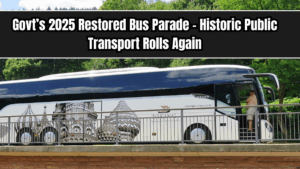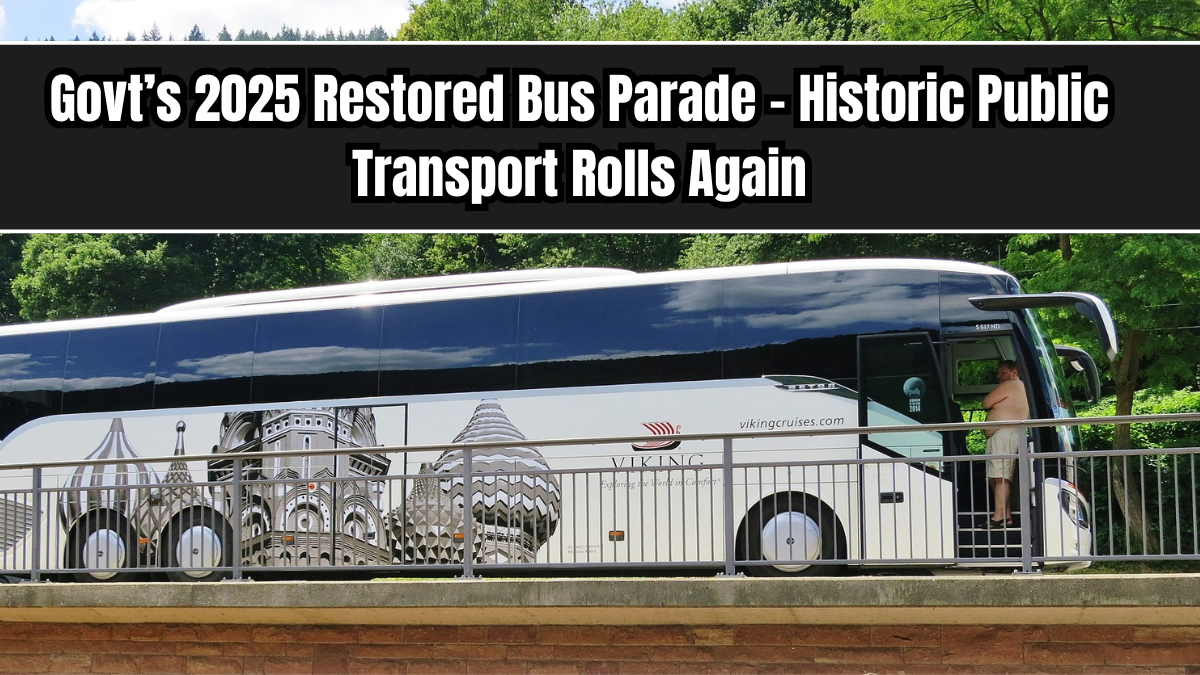India’s transport story is incomplete without its buses—vehicles that have carried millions over decades, connecting cities, towns, and villages. In 2025, the government is honoring this legacy by organizing the Restored Bus Parade 2025, a grand national event that brings back historic buses, fully refurbished and rolling once again on the roads.
The initiative is not only a nostalgic celebration but also an effort to preserve the history of public transportation in India, giving younger generations a glimpse of how buses shaped daily life long before modern highways and air-conditioned fleets.

A Rolling Museum on Wheels
The Restored Bus Parade functions as a moving museum. Dozens of buses from different decades have been meticulously refurbished and repainted to their original glory. These vehicles now drive along parade routes in major cities, turning streets into corridors of history.
Each bus represents a different era of transport, from the wooden-bodied buses of the 1940s to the brightly painted state transport buses of the 1970s and 80s. Many include original logos, ticketing machines, and conductor seats—preserved as authentic details for visitors to admire.
Heritage That Moves
Public buses in India were more than just vehicles—they were lifelines. For rural families, they meant access to markets and hospitals. For students, they meant education. For workers, they meant jobs in distant towns. The Restored Bus Parade 2025 pays tribute to this role, reminding citizens of the cultural and social impact buses had across generations.
Some of the restored models include:
-
Double-decker buses once iconic in cities like Mumbai and Kolkata.
-
State Transport Buses that connected small villages to big cities.
-
Luxury intercity coaches from the early 1990s.
-
Special festival buses decorated for fairs and cultural events.
Each one tells a story of a time when travel was simpler, slower, and deeply communal.
The Restoration Effort
Bringing these buses back to life was no easy task. Heritage mechanics, designers, and government transport departments worked together for months to refurbish the vehicles.
Key restoration tasks included:
-
Engine rebuilding for smooth, safe performance.
-
Body repair and repainting using original design references.
-
Interior restoration with period-specific seats, lights, and ticketing gear.
-
Historical accuracy checks by transport historians and auto experts.
The result is a fleet of buses that feel like time machines—authentic, safe, and spectacular.
The Parade Experience
The Restored Bus Parade 2025 is designed as a public festival. Cities hosting the parade organize cultural performances, exhibitions, and storytelling events alongside the buses. Spectators can even board select buses, experiencing what it was like to travel decades ago.
Families, school groups, and tourists are especially drawn to the event. For older generations, the parade is nostalgic. For younger visitors, it is a fascinating lesson in history.
Boosting Tourism and Culture
The bus parade also has a broader purpose: boosting tourism and cultural pride. By turning ordinary roads into heritage showcases, the event attracts domestic and international visitors alike.
Local artists and performers participate in the parade, adding music, dance, and theater inspired by regional transport stories. Souvenir stalls sell miniatures, photo books, and models of classic buses, creating an economic boost for small businesses.
Symbol of Sustainable Heritage
The Restored Bus Parade 2025 is not only about celebrating history—it also sends a message about sustainability and reuse. Instead of discarding old vehicles, they are preserved and given new life. This mindset encourages people to value restoration over replacement, supporting a culture of sustainability.
The government is also considering converting some restored buses into electric replicas, ensuring that while heritage is preserved, technology and eco-consciousness move forward hand in hand.
Looking Ahead
The success of the 2025 event is expected to pave the way for annual heritage parades in different states. In the future, organizers may also create permanent heritage bus museums where these vehicles can be stored and displayed between events.
There is even talk of introducing heritage bus tours, where restored vehicles will offer guided city rides, giving tourists a chance to experience historic transport firsthand.
Final Thoughts
The Restored Bus Parade 2025 is more than a celebration of vintage vehicles—it is a cultural event that brings India’s transport history to life. By putting buses back on the roads in all their restored glory, the event honors the role they played in shaping modern India.
For citizens, it’s a chance to reconnect with history. For artisans and mechanics, it’s recognition of their craft. And for India, it’s proof that even in the age of hyper-modern transport, there is still a place for heritage on the streets.
FAQs
What is the Restored Bus Parade 2025?
It is a national event in India where vintage buses are restored and showcased in parades across major cities.
Which buses are included in the parade?
The parade features double-decker buses, state transport models, intercity coaches, and festival-decorated buses from different decades.
Who restored the buses?
Heritage mechanics, transport departments, and historians worked together to repair, repaint, and preserve the original details of each bus.
Can visitors ride the restored buses?
Yes, some buses are open for the public to board, allowing them to experience historic interiors.
Why is this event important?
It celebrates India’s public transport heritage, boosts tourism, and promotes the idea of restoration and sustainability.
Will the Restored Bus Parade become an annual event?
Yes, the government plans to host heritage parades regularly and may also establish permanent heritage bus museums.
Does the event benefit local communities?
Yes, it creates tourism opportunities, supports local artists, and generates economic activity through exhibitions and souvenirs.
Click here to know more.
